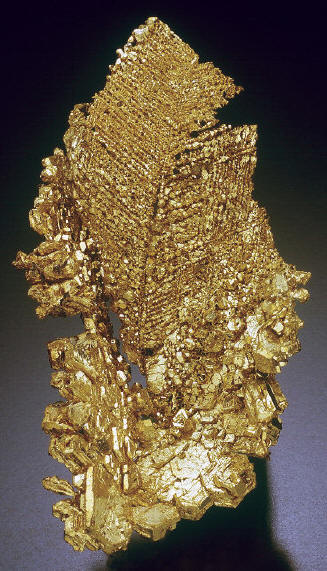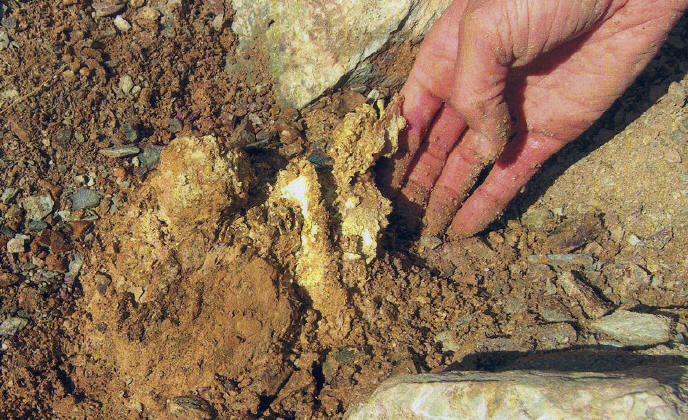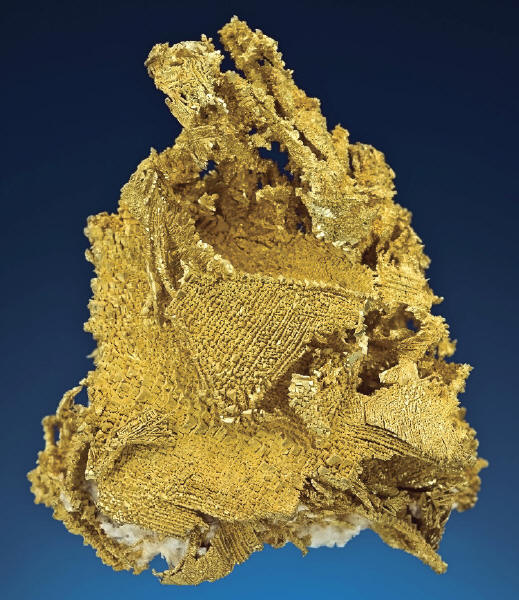Author: R. ScottWERSCHKY Date: 2014-9-24 18:55:44

Round Mountain townsite – original home to miners during early history of the mine, today almost a ghost town. S. Werschky photo.
OPERATIONS
The gold deposit at Round Mountainis mined using conventional open pitmining methods. The pit is 2330 by 1700m and 580 m deep from the top of the original mountain.
Benches are drilled,blasted, and then mined on 10.7 m liftsusing 136, 172, and 218 tonne haultrucks. Oxidized ore is placed on pads,and cyanide leached. Sulfide ore iscrushed, and processed in a CIL mill circuit.

Crystalized gold grading from spinel lawtwinned cuboctahedrons up into herringbones. Size 7.6 cm. Ex Miner’s Lunchboxnow in K&M Proctor coll. J. Scovil photo.
Placer ore and high-grade coarse gold ore is processed in a gravity plant,with the tails subsequently processed inthe mill or on the heap leach pads. Themine employs approximately 800 workers.

Crystalized gold showing classic herringbone formation and spinel law twinning of cubic crystals. Size 12 cm. K&M Proctor coll. J. Scovil photo.
There are presently an additional200 contract personnel working on mineexpansions. The mine controls almost21,000 hectares of mineral rights includingboth patented and unpatented federalmining claims in addition to placerclaims. The mining claims cover the areafrom Manhattan, 18 km to the south, toGold Hill, 8 km north of the present pit.
Gold Hill hosts a gold resource which willbe mined by the company in the verynear future.
GEOLOGY
The Round Mountain mine is situatedat the eastern edge of the Oligoceneaged Round Mountain Caldera complex.
The caldera has been dated at 26.5 ma,and is only 0.5 ma older than the mineralization.
The volcanics are densely topoorly welded tuffs of rhyolitic composition.
The volcanics were deposited onboth a Cretaceous granite and the Paleozoicbasement rocks into which thegranite intruded. Paleozoic rocks arepredominantly marine calcareous andclastic sediments which have been metamorphosedto argillites, phyllites, andquartzites adjacent to the intrusive.
Caldera formation has structurally modifiedthe area with ring and radial faultingin addition to the rafting of largeblocks of basement rocks into the calderaalong the ring faults. The region wasthen modified by north-trending Basinand Range faulting which down-droppedblocks westward to the valley. Quaternarygravels overlay the western portionof the deposit. Rich gold placers arefound at the base of the gravel sequence.
Gold ores at the Round Mountainmine can be separated into 5 distinctcategories based on host rock lithology,alteration, and structure. Ore grade mineralizationis found in all of the calderarelated volcanics as well as the underlyingPaleozoic sediments. Of these variousore types, only the veining isimportant to mineral specimen development.
Vein development at Round Mountainis a function of fracture related openspace. Fractures occur in many fashionsincluding structural intersections, tensionalgashes, rock density refraction,and dip deflections along structures andlithologic contacts. The fractures werethen filled by quartz veins during themineralizing event. The most importantvein in the deposit occurs along the contactbetween a poorly welded tuff and adensely weld tuff. Changes in dip of thecontact created dilatant zones that filledwith quartz during mineralization. Thequartz was quite gold rich in this vein,making it the largest high grade zone inthe mine producing more than 4 tonnesof gold! Probably the next most importantvein type occurs as vein fillingsin tensional fractures in the Paleozoicrocks rafted into the caldera along radial structures. These tensional gashes arequite abundant, and are responsible formany of the gold specimens collected.

Crystallized gold in situ after blasting. Kinross photo.
MINERALIZATION
Mineralogy of the deposit is quitesimple. The Eocene volcanics are rhyolitic in composition, made up of quartz,biotite, plagioclase, and sanidine. Underlyingthe volcanics are the Paleozoiccalcareous and clastic sediments. Giventhe eruptive nature of the volcanics, andthe fine grained sedimentary nature ofthe Paleozics, there are no specimenquality minerals found in the host rocks.

Crystalized gold. Size 3.1 cm. A. Day coll. J. Scovil photo.
Hydrothermal mineralization, hosted by the volcanics, and to a lesser degree thePaleozoic sediments, consists of quartzveining with adularia (orthoclase), calcite,pyrite, gold, and silver. The onlyspecimen grade minerals found in themine to date occur in the veins and arelimited to gold with minor amounts ofquartz. Pyrite crystals are always tiny,and frozen in quartz or in altered rock.

Cubic spinel law twinned gold crystals forming herringbones. Size 4.2 cm. N. Prenn collection. J. Scovil photo.
The calcite seems to have filled allspaces not already filled in by quartz.
Hydrothermal alteration of the hostrocks and veins is characterized byargillic, sericitic, and chloritic zones asevidenced by fine grained minerals suchas illite, smectite, sericite, and chlorite.
Even though the alteration assemblagesdo not produce nice mineral specimens,they are very important to mineral collectingin that the clays replaced bothquartz and adularia, frequently leavingbeautifully crystalline gold surroundedby soft clays which can be easily cleanedoff by simple washing.








 YueGongAnBei 44051102000467
YueGongAnBei 44051102000467


 |
|